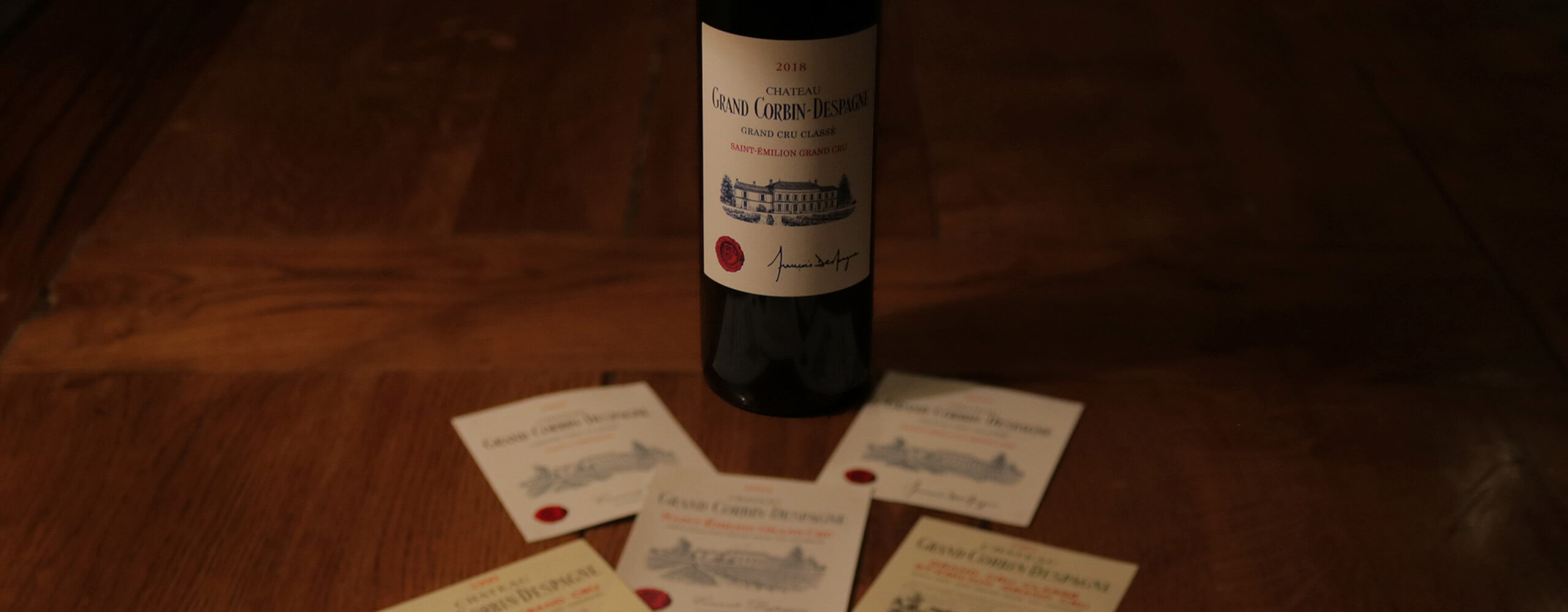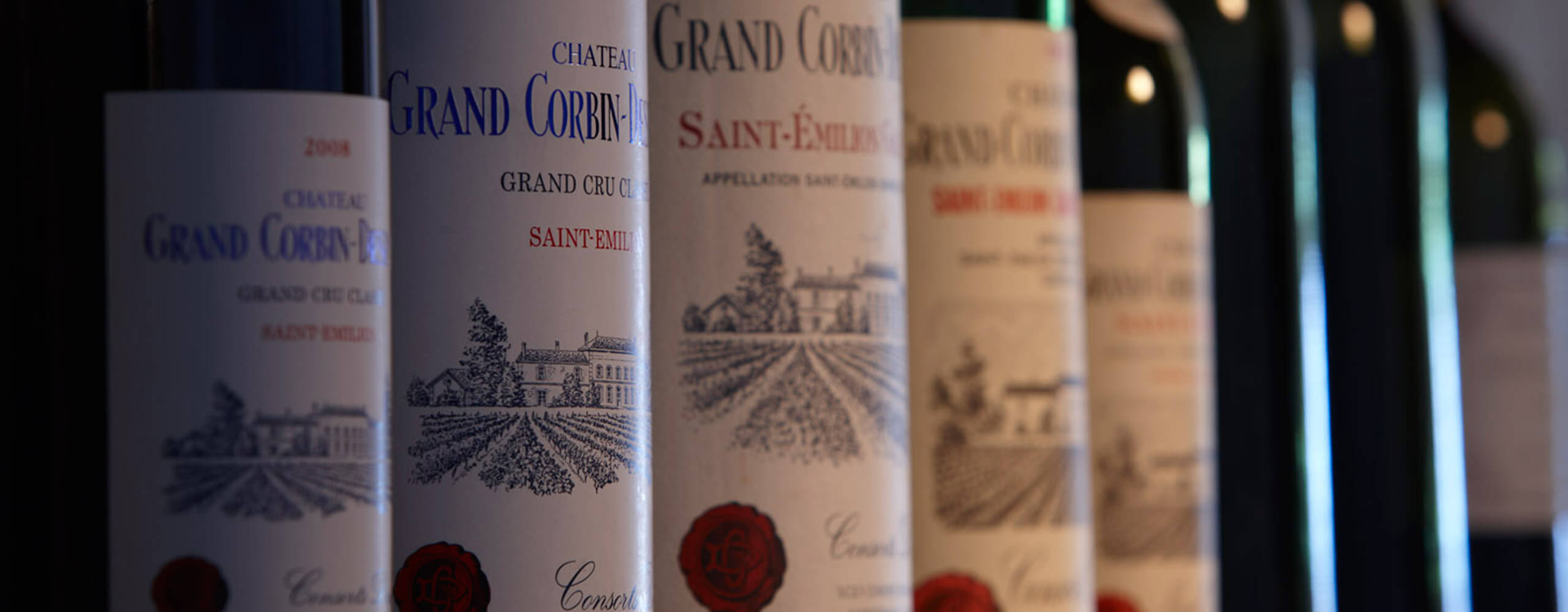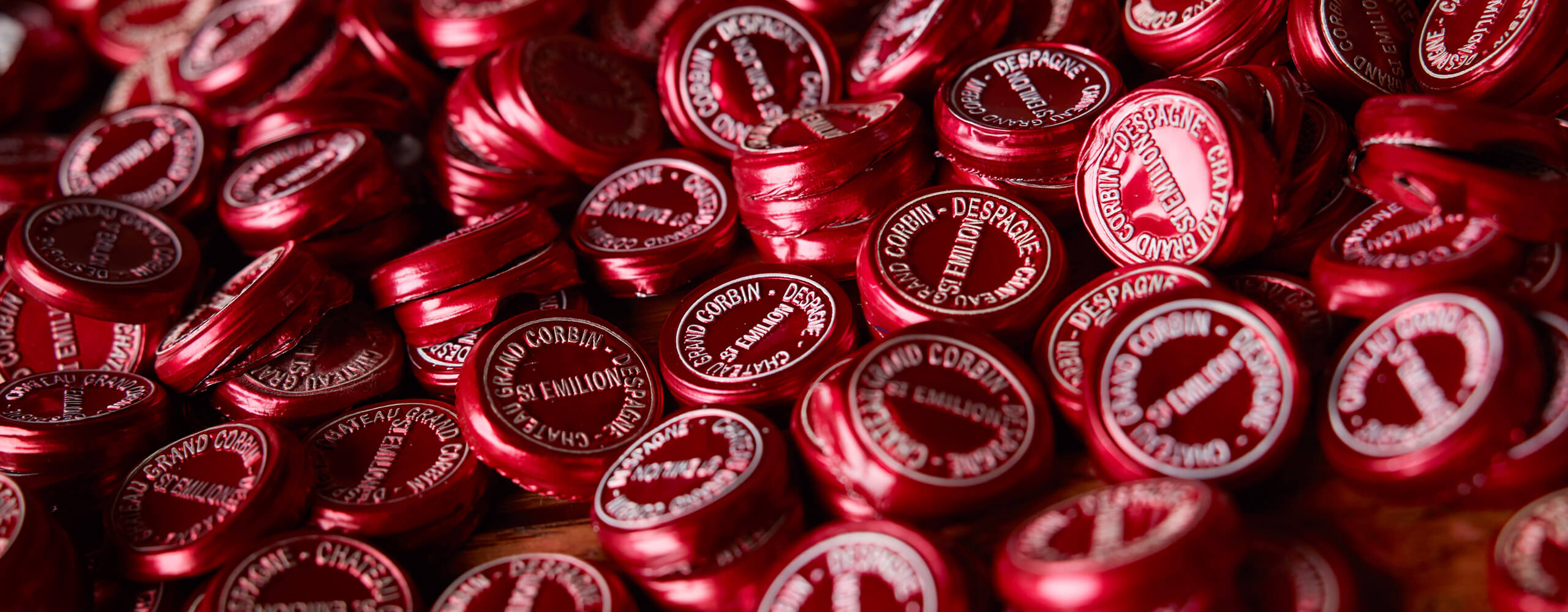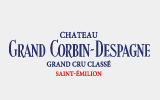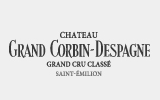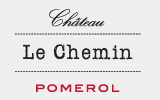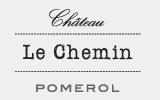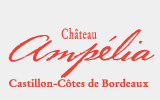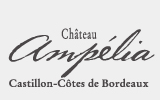- 2022
- 2021
- 2020
- 2019
- 2018
- 2017
- 2016
- 2015
- 2014
- 2013
- 2012
- 2011
- 2010
- 2009
- 2008
- 2007
- 2006
- 2005
- 2004
- 2003
- 2002
- 2001
- 2000
- 1999
- 1998
- 1997
- 1996

2022 vintage
The 211th vintage of the Despagne family on the Grand Corbin terroir.
Download the technical data sheetPeak maturity
-
Harvesting dates
– 28/09/2022 : Young Merlot
– 01/10/2022 : Merlot
– 08/10/2022 : Cabernets2020 blend
– 75% Merlot
– 24% Cabernet-Franc
– 1% Cabernet-SauvignonAgeing
– 50% new barrels
– 40% one year old barrels
– 10% amphore -
Yield
36 hl/haProduction forecast
80 000 bottles, 6 650 cases
General technical data
Family-owned estate since 1812.
-
Location
In the north of the Saint-Emilion appellation, adjacent to PomerolAppellation
Saint-Emilion Grand CruClassification
Grand Cru ClasséSurface area
28.79 hectaresSoils
Clay-sand over iron deposits and ancient sands over clayAverage age of the vines
38 yearsRootstocks
101-14, 3309, RipariaVine-growing methods
ploughing or a grass cover
crop without any use of weedkillers.
Certified as organically-farmed and an organic wine
since 2013 by Qualisud FR-BIO-16. -
Density of plantation
6,000 to 8,000 vines per hectareCanopy management work
De-budding, removal of double shoots, de-leafing, crop thinning, removal of lateral shootsHarvesting
By hand in small crates with 5 successive sortingsVinification
Different operations that can vary according to plot batches and vintage : numerous short pump-overs, rack and return (délestage) and punching down of the cap (pigeage)Bottling
21 months after the harvestAnnual production
70,000 to 100,000 bottles depending on the vintageSecond wine
Petit Corbin-Despagne Saint-Emilion Grand Cru
Download the technical data sheetPress commentsPeak maturity

2021 vintage
The 210th vintage of the Despagne family on the Grand Corbin terroir.
Download the technical data sheetPeak maturity
-
Harvesting dates
– 28/09/2021 : Young Merlot
– 01/10/2021 : Merlot
– 08/10/2021 : Cabernets2020 blend
– 72% Merlot
– 27% Cabernet-Franc
– 1% Cabernet-SauvignonAgeing
– 50% new barrels
– 40% one year old barrels
– 10% amphore -
Yield
19 hl/haProduction
827 half-bottles
43 981 bottles
1 003 magnums
54 double-magnums
3 jéroboams
20 impériales
General technical data
Family-owned estate since 1812.
-
Location
In the north of the Saint-Emilion appellation, adjacent to PomerolAppellation
Saint-Emilion Grand CruClassification
Grand Cru ClasséSurface area
28.79 hectaresSoils
Clay-sand over iron deposits and ancient sands over clayAverage age of the vines
38 yearsRootstocks
101-14, 3309, RipariaVine-growing methods
ploughing or a grass cover
crop without any use of weedkillers.
Certified as organically-farmed and an organic wine
since 2013 by Qualisud FR-BIO-16. -
Density of plantation
6,000 to 8,000 vines per hectareCanopy management work
De-budding, removal of double shoots, de-leafing, crop thinning, removal of lateral shootsHarvesting
By hand in small crates with 5 successive sortingsVinification
Different operations that can vary according to plot batches and vintage : numerous short pump-overs, rack and return (délestage) and punching down of the cap (pigeage)Bottling
21 months after the harvestAnnual production
70,000 to 100,000 bottles depending on the vintageSecond wine
Petit Corbin-Despagne Saint-Emilion Grand Cru
Download the technical data sheetPress commentsPeak maturity

2020 vintage
The 209th vintage of the Despagne family on the Grand Corbin terroir.
Download the technical data sheetPeak maturity
-
Harvesting dates
– 10/09/2020 : Young Merlot
– 14/09/2020: Merlot
– 21/09/2020 : Cabernets2020 blend
– 75% Merlot
– 24% Cabernet-Franc
– 1% Cabernet-SauvignonAgeing
– 50% new barrels
– 50% one year old barrels -
Yield
36 hl/haProduction
1 819 half-bottles
100 315 bottles
3 085 magnums
86 double-magnums
6 jéroboams
26 impériales
General technical data
Family-owned estate since 1812.
-
Location
In the north of the Saint-Emilion appellation, adjacent to PomerolAppellation
Saint-Emilion Grand CruClassification
Grand Cru ClasséSurface area
28.79 hectaresSoils
Clay-sand over iron deposits and ancient sands over clayAverage age of the vines
38 yearsRootstocks
101-14, 3309, RipariaVine-growing methods
ploughing or a grass cover
crop without any use of weedkillers.
Certified as organically-farmed and an organic wine
since 2013 by Qualisud FR-BIO-16. -
Density of plantation
6,000 to 8,000 vines per hectareCanopy management work
De-budding, removal of double shoots, de-leafing, crop thinning, removal of lateral shootsHarvesting
By hand in small crates with 5 successive sortingsVinification
Different operations that can vary according to plot batches and vintage : numerous short pump-overs, rack and return (délestage) and punching down of the cap (pigeage)Bottling
21 months after the harvestAnnual production
70,000 to 100,000 bottles depending on the vintageSecond wine
Petit Corbin-Despagne Saint-Emilion Grand Cru
Download the technical data sheetPress commentsPeak maturity

2019 vintage
The 208th vintage of the Despagne family on the Grand Corbin terroir.
Download the technical data sheetPeak maturity
-
Harvesting dates
– 18/09/2019 : Young Merlot
– 23/09/2019: Merlot
– 30/09/2019 : Cabernets2019 blend
– 75% Merlot
– 24% Cabernet-Franc
– 1% Cabernet-SauvignonAgeing
– 50% new barrels
– 50% one year old barrels -
Yield
36 hl/haProduction forecast
600 half-bottles
80 460 bottles
2 200 magnums
90 double-magnums
16 impériales
General technical data
Family-owned estate since 1812.
-
Location
In the north of the Saint-Emilion appellation, adjacent to PomerolAppellation
Saint-Emilion Grand CruClassification
Grand Cru ClasséSurface area
28.79 hectaresSoils
Clay-sand over iron deposits and ancient sands over clayAverage age of the vines
38 yearsRootstocks
101-14, 3309, RipariaVine-growing methods
ploughing or a grass cover
crop without any use of weedkillers.
Certified as organically-farmed and an organic wine
since 2013 by Qualisud FR-BIO-16. -
Density of plantation
6,000 to 8,000 vines per hectareCanopy management work
De-budding, removal of double shoots, de-leafing, crop thinning, removal of lateral shootsHarvesting
By hand in small crates with 5 successive sortingsVinification
Different operations that can vary according to plot batches and vintage : numerous short pump-overs, rack and return (délestage) and punching down of the cap (pigeage)Bottling
21 months after the harvestAnnual production
70,000 to 100,000 bottles depending on the vintageSecond wine
Petit Corbin-Despagne Saint-Emilion Grand Cru
Download the technical data sheetPress commentsPeak maturity

2018 vintage
The 207th vintage of the Despagne family on the Grand Corbin terroir.
Download the technical data sheetPress commentsPeak maturity
-
Harvesting dates
– 19/09/2018 : Young Merlot
– 24/09/2018: Merlot
– 02/10/2018 : Cabernets2018 blend
– 75% Merlot
– 24% Cabernet-Franc
– 1% Cabernet-SauvignonAgeing
– 50% new barrels
– 40% second-fill barrels
– 10% third-fill barrels -
Yield
34 hl/haProduction
805 half-bottles
76 538 bottles
2 515 magnums
135 double-magnums
30 impériales
6 salmanazars
General technical data
Family-owned estate since 1812.
-
Location
In the north of the Saint-Emilion appellation, adjacent to PomerolAppellation
Saint-Emilion Grand CruClassification
Grand Cru ClasséSurface area
28.79 hectaresSoils
Clay-sand over iron deposits and ancient sands over clayAverage age of the vines
38 yearsRootstocks
101-14, 3309, RipariaVine-growing methods
ploughing or a grass cover
crop without any use of weedkillers.
Certified as organically-farmed and an organic wine
since 2013 by Qualisud FR-BIO-16. -
Density of plantation
6,000 to 8,000 vines per hectareCanopy management work
De-budding, removal of double shoots, de-leafing, crop thinning, removal of lateral shootsHarvesting
By hand in small crates with 5 successive sortingsVinification
Different operations that can vary according to plot batches and vintage : numerous short pump-overs, rack and return (délestage) and punching down of the cap (pigeage)Bottling
21 months after the harvestAnnual production
70,000 to 100,000 bottles depending on the vintageSecond wine
Petit Corbin-Despagne Saint-Emilion Grand Cru
Download the technical data sheetPress commentsPeak maturity

2017 vintage
The frosts that struck on 26, 27 and 28 April destroyed 95% of our vine shoots.
Subsequent shooting of the counter-buds failed to produce shoots bearing quality fruit.
It was decided not to produce any Grand Vin or any Second Wine either, so as not to present a level of quality that didn’t conform to the rigorous standards of a Grand Cru Classé and its Second Wine.
We have thus sought to preserve our image of a growth producing very high quality wines.
-
Production
0 bottle
General technical data
Family-owned estate since 1812.
-
Location
In the north of the Saint-Emilion appellation, adjacent to PomerolAppellation
Saint-Emilion Grand CruClassification
Grand Cru ClasséSurface area
28.79 hectaresSoils
Clay-sand over iron deposits and ancient sands over clayAverage age of the vines
39 yearsRootstocks
101-14, 3309, RipariaVine-growing methods
ploughing or a grass
cover crop without any use of weedkillers.
Certified as organically-farmed and an
organic wine since 2013 by Qualisud FR-BIO16. -
Density of plantation
6,000 to 8,000 vines per hectareCanopy management work
De-budding, removal of double shoots, de-leafing, crop thinning, removal of lateral shootsHarvesting
By hand in small crates with 5 successive sortingsVinification
Different operations that can vary according to plot batches and vintage : numerous short pump-overs, rack and return (délestage) and punching down of the cap (pigeage)Annual production
70,000 to 100,000 bottles depending on the vintageSecond wine
Petit Corbin-Despagne Saint-Emilion Grand Cru

2016 vintage
The 205th vintage of the Despagne family on the Grand Corbin terroir.
Download the technical data sheetPress commentsPeak maturity
-
Harvesting dates
– 29/09/2016 for the young Merlot
– 03/10 to 12/10/2016 for the Merlot
– 13/10 to 14/10/2016 for the Cabernets2016 blend
– 75% Merlot
– 24% Cabernet-Franc
– 1% Cabernet-SauvignonAgeing
– 50% new barrels
– 40% second-fill barrels
– 10% third-fill barrels -
Yield
38 hl/haProduction
1,500 half-bottles,
86,731 bottles,
3,476 magnums,
90 double-magnums
15 impériales,
1 nabuchodonosor
General technical data
Family-owned estate since 1812.
-
Location
In the north of the Saint-Emilion appellation, adjacent to PomerolAppellation
Saint-Emilion Grand CruClassification
Grand Cru ClasséSurface area
28.79 hectaresSoils
Clay-sand over iron deposits and ancient sands over clayAverage age of the vines
39 yearsRootstocks
101-14, 3309, RipariaVine-growing methods
Ploughing or a grass cover
crop without any use of weedkillers.
Certified as organically-farmed and an organic wine
since 2013 by Qualisud FR-BIO-16. -
Density of plantation
6,000 to 8,000 vines per hectareCanopy management work
De-budding, removal of double shoots, de-leafing, crop thinning, removal of lateral shootsHarvesting
By hand in small crates with 5 successive sortingsVinification
Different operations that can vary according to plot batches and vintage : numerous short pump-overs, rack and return (délestage) and punching down of the cap (pigeage)Bottling
21 months after the harvestAnnual production
70,000 to 100,000 bottles depending on the vintageSecond wine
Petit Corbin-Despagne Saint-Emilion Grand Cru

2015 vintage
The 204th vintage of the Despagne family on the Grand Corbin terroir.
Download the technical data sheetPress commentsPeak maturity
-
Harvesting dates
– 17/09/2015 for the young Merlot
– 21/09/2015 for the Merlot
– 29/09/2015 for the Cabernets2015 blend
– 75% Merlot
– 24% Cabernet-Franc
– 1% Cabernet-SauvignonAgeing
– 50% new barrels
– 40% second-fill barrels
– 10% third-fill barrels -
Yield
38 hl/haProduction
914 half-bottles,
91,424 bottles,
3,794 magnums,
102 double-magnums,
21 impériales
General technical data
Family-owned estate since 1812.
-
Location
In the north of the Saint-Emilion appellation, adjacent to PomerolAppellation
Saint-Emilion Grand CruClassification
Grand Cru ClasséSurface area
28.79 hectaresSoils
Clay-sand over iron deposits and ancient sands over clayAverage age of the vines
39 yearsRootstocks
101-14, 3309, RipariaVine-growing methods
Ploughing or a grass cover
crop without any use of weedkillers.
Certified as organically-farmed and an organic wine
since 2013 by Agrocert FR-BIO07 -
Density of plantation
6,000 to 8,000 vines per hectareCanopy management work
De-budding, removal of double shoots, de-leafing, crop thinning, removal of lateral shootsHarvesting
By hand in small crates with 5 successive sortingsVinification
Different operations that can vary according to plot batches and vintage : numerous short pump-overs, rack and return (délestage) and punching down of the cap (pigeage)Bottling
21 months after the harvestAnnual production
70,000 to 100,000 bottles depending on the vintageSecond wine
Petit Corbin-Despagne Saint-Emilion Grand Cru

2014 vintage
The 203rd vintage of the Despagne family on the Grand Corbin terroir.
Download the technical data sheetPress commentsPeak maturity
-
Harvesting dates
– 29/09/2014 for the Merlot
– 07/10/2014 for the Cabernet-Franc2014 blend
– 70% Merlot
– 29% Cabernet-Franc
– 1% Cabernet-SauvignonAgeing
– 40% new barrels
– 50% second-fill barrels
– 10% third-fill barrels -
Yield
38 hl/haProduction
1,004 half-bottles,
76,712 bottles,
1,631 magnums,
64 double-magnums,
20 impériales,
1 salmanazar,
1 balthazar,
3 melchiors.
General technical data
Family-owned estate since 1812.
-
Location
In the north of the Saint-Emilion appellation, adjacent to PomerolAppellation
Saint-Emilion Grand CruClassification
Grand Cru ClasséSurface area
28.79 hectaresSoils
Clay-sand over iron deposits and ancient sands over clayAverage age of the vines
39 yearsRootstocks
101-14, 3309, RipariaVine-growing methods
Ploughing or a grass cover
crop without any use of weedkillers.
Certified as organically-farmed and an organic wine
since 2013 by Agrocert FR-BIO07 -
Density of plantation
6,000 to 7,000 vines/hectare
New plantations : 7,200 to 8,200 vines/hectareCanopy management work
De-budding, removal of double shoots, de-leafing, crop thinning, removal of lateral shootsHarvesting
By hand in small crates with 5 successive sortingsVinification
Different operations that can vary according to plot batches and vintage : numerous short pump-overs, rack and return (délestage) and punching down of the cap (pigeage)Bottling
21 months after the harvestAnnual production
70,000 to 100,000 bottles depending on the vintageSecond wine
Petit Corbin-Despagne Saint-Emilion Grand Cru

2013 vintage
The 202nd vintage of the Despagne family on the Grand Corbin terroir.
Download the technical data sheetPress commentsPeak maturity
-
Harvesting dates
– 30/09/2013 for the Merlot
– 07/10/2013 for the Cabernet-Franc2013 blend
– 70% Merlot
– 29% Cabernet-Franc
– 1% Cabernet-SauvignonAgeing
– 40% new barrels
– 50% second-fill barrels
– 10% third-fill barrels -
Yield
20 hl/haProduction
305 half-bottles,
39,270 bottles
380 magnums
10 double-Magnums
5 imperiales
General technical data
Family-owned estate since 1812.
-
Location
In the north of the Saint-Emilion appellation, adjacent to PomerolAppellation
Saint-Emilion Grand CruClassification
Grand Cru ClasséSurface area
28.79 hectaresSoils
Clay-sand over iron deposits and ancient sands over clayAverage age of the vines
39 yearsRootstocks
101-14, 3309, RipariaVine-growing methods
Ploughing or a grass cover
crop without any use of weedkillers.
Certified as organically-farmed and an organic wine
since 2013 by Agrocert FR-BIO07 -
Density of plantation
6,000 to 7,000 vines per hectareCanopy management work
De-budding, removal of double shoots, de-leafing, crop thinning, removal of lateral shootsHarvesting
By hand in small crates with 5 successive sortingsVinification
Different operations that can vary according to plot batches and vintage : numerous short pump-overs, rack and return (délestage) and punching down of the cap (pigeage)Bottling
21 months after the harvestAnnual production
70,000 to 100,000 bottles depending on the vintageSecond wine
Petit Corbin-Despagne Saint-Emilion Grand Cru

2012 vintage
The 201st vintage of the Despagne family on the Grand Corbin terroir.
Download the technical data sheetPress commentsPeak maturity
-
Harvesting dates
– 04/10/2012 for the Merlot
– 11/10/2012 for the Cabernet-Franc2012 blend
– 75% Merlot
– 24% Cabernet-Franc
– 1% Cabernet-SauvignonAgeing
– 50% new barrels
– 50% second-fill and third-fill barrels -
Yield
34 hl/haProduction
500 half-bottles
75,965 bottles
2,137 magnums
58 double-magnums
2 jéroboams
18 impériales
General technical data
Family-owned estate since 1812.
-
Location
In the north of the Saint-Emilion appellation, adjacent to PomerolAppellation
Saint-Emilion Grand CruClassification
Grand Cru ClasséSurface area
28.79 hectaresSoils
Clay-sand over iron deposits and ancient sands over clayAverage age of the vines
39 yearsRootstocks
101-14, 3309, RipariaVine-growing methods
Ploughing or a grass cover
crop without any use of weedkillers.
In the process of converting to an Organically-Grown
Vineyard since 2010 (2012: third year in the
conversion process) under the control of Agrocert FR-007. -
Density of plantation
6,000 to 7,000 vines per hectareCanopy management work
De-budding, removal of double shoots, de-leafing, crop thinning, removal of lateral shootsHarvesting
By hand in small crates with 4 successive sortingsVinification
Different operations that can vary according to plot batches and vintage : numerous short pump-overs, rack and return (délestage) and punching down of the cap (pigeage)Bottling
21 months after the harvestAnnual production
70,000 to 100,000 bottles depending on the vintageSecond wine
Petit Corbin-Despagne Saint-Emilion Grand Cru

2011 vintage
200th vintage of the Despagne family
Download the technical data sheetPress commentsPeak maturity
-
Harvesting dates
– 15/09/2011 for the Merlot
– 26/09/2011 for the Cabernet-Franc2011 blend
– 70% Merlot
– 29% Cabernet-Franc
– 1% Cabernet-SauvignonAgeing
– 50% new barrels
– 50% second-fill and third-fill barrels -
Yield
38 hl/haProduction
467 half-bottles
70,000 bottles
648 magnums
54 double-magnums
26 imperiales
General technical data
Family-owned estate since 1812.
-
Location
In the north of the Saint-Emilion appellation, adjacent to PomerolAppellation
Saint-Emilion Grand CruClassification
Grand Cru ClasséSurface area
26,80 hectaresSoils
Clay-sand over iron deposits and ancient sands over clayAverage age of the vines
38 yearsRootstocks
101-14, 3309, RipariaVine-growing methods
Ploughing or a grass cover
crop without any use of weedkillers.
In the process of converting to an OrganicallyGrown Vineyard since 2010. -
Density of plantation
6,000 to 7,000 vines per hectareCanopy management work
De-budding, removal of double shoots, de-leafing, crop thinning, removal of lateral shootsHarvesting
By hand in small crates with 4 successive sortingsVinification
Different operations that can vary according to plot batches and vintage : numerous short pump-overs, rack and return (délestage) and punching down of the cap (pigeage)Bottling
21 months after the harvestAnnual production
70,000 to 100,000 bottles depending on the vintageSecond wine
Petit Corbin-Despagne Saint-Emilion Grand Cru

2010 vintage
The 199th vintage of the Despagne family
Download the technical data sheetPress commentsPeak maturity
-
Harvesting dates
– 27/09/2010 for the Merlot
– 06/10/2010 for the Cabernet-Franc2010 blend
– 75% Merlot
– 24% Cabernet-Franc
– 1% Cabernet-SauvignonAgeing
– 50% new barrels
– 50% second-fill and third-fill barrels -
Yield
34 hl/haProduction
550 half-bottles
85,643 bottles
1,995 magnums
15 jéroboams
2 balthazars
2 salmanazars
General technical data
Family-owned estate since 1812.
-
Location
In the north of the Saint-Emilion appellation, adjacent to PomerolAppellation
Saint-Emilion Grand CruClassification
Grand Cru ClasséSurface area
28,80 hectaresSoils
Clay-sand over iron deposits and ancient sands over clayAverage age of the vines
40 yearsRootstocks
101-14, 3309, RipariaVine-growing methods
Ploughing or a grass cover
crop without any use of weedkillers.
In the process of converting to an Organically-Grown
Vineyard since 2010. -
Density of plantation
6,000 to 7,000 vines per hectareCanopy management work
De-budding, removal of double shoots, de-leafing, crop thinning, removal of lateral shootsHarvesting
By hand in small crates with 4 successive sortingsVinification
Different operations that can vary according to plot batches and vintage : numerous short pump-overs, rack and return (délestage) and punching down of the cap (pigeage)Bottling
21 months after the harvestAnnual production
70,000 to 100,000 bottles depending on the vintageSecond wine
Petit Corbin-Despagne Saint-Emilion Grand Cru

2009 vintage
The 198th vintage of the Despagne family
Download the technical data sheetPress commentsPeak maturity
-
Harvesting dates
– 24/09/2009 for the Merlot
– 05/10/2009 for the Cabernet-Franc2009 blend
– 75% Merlot
– 24% Cabernet-Franc
– 1% Cabernet-SauvignonAgeing
– 50% new barrels
– 50% second-fill and third-fill barrels -
Yield
38 hl/haProduction
490 half-bottles
83,871 bottles
2,439 magnums
94 double-magnums
1 jéroboam
27 impériales
3 balthazars
General technical data
Family-owned estate since 1812.
-
Location
In the north of the Saint-Emilion appellation, adjacent to PomerolAppellation
Saint-Emilion Grand CruClassification
Grand Cru ClasséSurface area
26,80 hectaresSoils
Clay-sand over iron deposits and ancient sands over clayAverage age of the vines
42 yearsRootstocks
101-14, 3309, RipariaVine-growing methods
Ploughing or a grass cover crop
without any use of weedkillers.
Approved as a vineyard using integrated vine-growing
practices, under the supervision of AFAQ-AFNOR,
certified by Chartre Terra Vitis. -
Density of plantation
6,000 to 7,000 vines per hectareCanopy management work
De-budding, removal of double shoots, de-leafing, crop thinning, removal of lateral shootsHarvesting
By hand in small crates with 4 successive sortingsVinification
Different operations that can vary according to plot batches and vintage : numerous short pump-overs, rack and return (délestage) and punching down of the cap (pigeage)Bottling
21 months after the harvestAnnual production
70,000 to 100,000 bottles depending on the vintageSecond wine
Petit Corbin-Despagne Saint-Emilion Grand Cru

2008 vintage
The 197th vintage of the Despagne family
Download the technical data sheetPress commentsPeak maturity
-
Harvesting dates
– 06/10/2008 for the Merlot
– 13/10/2008 for the Cabernet-Franc2008 blend
– 75% Merlot
– 24% Cabernet-Franc
– 1% Cabernet-SauvignonAgeing
– 40% new barrels
– 60% second-fill and third-fill barrels -
Yield
32 hl/haProduction
552 half-bottles
69,772 bottles
2,230 magnums
75 double-magnums
15 impériales
General technical data
Family-owned estate since 1812.
-
Location
In the north of the Saint-Emilion appellation, adjacent to PomerolAppellation
Saint-Emilion Grand CruClassification
Grand Cru ClasséSurface area
26,80 hectaresSoils
Clay-sand over iron deposits and ancient sands over clayAverage age of the vines
46 yearsRootstocks
101-14, 3309, RipariaVine-growing methods
Ploughing or a grass cover crop
without any use of weedkillers.
Approved as a vineyard using integrated vine-growing
practices, under the supervision of AFAQ-AFNOR,
certified by Chartre Terra Vitis. -
Density of plantation
6,000 to 7,000 vines per hectareCanopy management work
De-budding, removal of double shoots, de-leafing, crop thinning, removal of lateral shootsHarvesting
By hand in small crates with 4 successive sortingsVinification
Different operations that can vary according to plot batches and vintage : numerous short pump-overs, rack and return (délestage) and punching down of the cap (pigeage)Bottling
21 months after the harvestAnnual production
70,000 to 100,000 bottles depending on the vintageSecond wine
Petit Corbin-Despagne Saint-Emilion Grand Cru

2007 vintage
The 196th vintage of the Despagne family
Download the technical data sheetPress commentsPeak maturity
This was a vintage to test the vine-growers. It needed careful observation, patience and the ability to react quickly to circumstances.
Although the year was very challenging, in the end it was a real pleasure when finally all the hard work was rewarded with wines that turned out to be fruity, fleshy and perfectly balanced.
Our vine-growing methods have been environmentally-friendly for over ten years now. We have set up a think-tank to reflect on sustainability and wine-making effluent treatment. The vineyard has been granted integrated crop management status (la lutte raisonnée), and we have obtained a charter for sustainable economy (Terra Vitis). As from the 2007 vintage, new ground was broken with the introduction of organic vine-growing methods.
This vintage was also the cue for the introduction of a different sorting system and the acquisition of new sorting tables, including an automatic table which sorts the grapes using an air knife in order to eliminate any unwanted berries.
Growing season
A very hot April caused the vines to begin shooting (bud-break) very early. The flowering process was very even, taking place around 24th May. Despite unsettled weather there was very little problem with fruit setting. The vine cycle was then subjected to a phase of downy mildew threat, due to damp conditions during May and June.
Close monitoring of the vineyard was essential to preserve the potential crop size. Each vine’s crop load was then adjusted at veraison (the optimal moment for crop thinning). A few rain showers at the end of August gave some cause for concern for the health of the grapes. Fortunately, the sunniest and driest September of the last 60 years ensured an excellent completion of the ripening process.
Harvest
Getting the dates right for the harvest was crucial for a successful vintage. Taking into account the last sixty years, the average time between the flowering and the harvesting is 110 days. Tasting the berries on the vines enabled us to harvest each plot’s grapes at optimal quality and in perfect health well beyond this average time span.
Vinification
Each plot, each batch and each vat was vinified according to its potential with numerous short pump-overs to extract a fine tannic structure. The duration and the frequency of the pump-overs were adapted to the constitution of the grape skins.
First impressions during the wine’s ageing
Many lots displayed lovely balance. Potential alcoholic degree was lower than in previous years (around 12.5°). Aromatic expression was superb. Tannins were present and firm –the ageing process would bring the necessary flesh to balance them.
-
Harvesting dates
– 25/09/2007 for the Merlot
– 08/10/2007 for the Cabernet-Franc2007 blend
– 77% Merlot
– 22% Cabernet-Franc
– 1% Cabernet-SauvignonAgeing
– 40% new barrels
– 60% second-fill and third-fill barrels2016 -
Yield
38 hl/haProduction
460 half-bottles
75,597 bottles
2,411 magnums
25 double-magnums
10 impériales
General technical data
Family-owned estate since 1812.
-
Location
In the north of the Saint-Emilion appellation, adjacent to PomerolAppellation
Saint-Emilion Grand CruClassification
Grand Cru ClasséSurface area
26,80 hectaresSoils
Clay-sand over iron deposits and ancient sands over clayAverage age of the vines
45 yearsRootstocks
101-14, 3309, RipariaVine-growing methods
Ploughing or a grass cover
crop without any use of weedkillers.
Approved as a vineyard using integrated vinegrowing practices, under the supervision of AFAQ-AFNOR, certified by Chartre Terra Vitis. -
Density of plantation
6,000 to 7,000 vines per hectareCanopy management work
De-budding, removal of double shoots, de-leafing, crop thinning, removal of lateral shootsHarvesting
By hand in small crates with 4 successive sortingsVinification
Different operations that can vary according to plot batches and vintage : numerous short pump-overs, rack and return (délestage) and punching down of the cap (pigeage)Bottling
21 months after the harvestAnnual production
70,000 to 100,000 bottles depending on the vintageSecond wine
Petit Corbin-Despagne Saint-Emilion Grand Cru

2006 vintage
The 195th vintage of the Despagne family
Download the technical data sheetPress commentsPeak maturity
The new Saint-Emilion classification confirmed our growing reputation for uncompromising quality levels since 1993.
This 2006 vintage therefore had a very special flavour, since these grapes would be classified Grand Cru Classé and had to be worthy of that rank.
Growing season
The 2006 flowering process was very smooth with a pollination peak occurring on June 6th. The vine cycle then had a period of very high temperatures and drought which caused water deficit stress in the vines and consequently an early stop in vegetation growth –a necessary element for good ripening of the grapes.
The sunshine and then the cool temperatures during August enabled slow ripening, good for keeping fruit potential in the berries. The beginning of September brought intense heat, which was ideal for the ripening of the tannins.
The rain that fell in mid-September had no adverse effect on the health of the grapes, thanks to the early stop in vine vegetation growth. The careful work carried out throughout the season to enhance quality (removing double shoots, crop thinning and de-leafing) had been well worth all the efforts.
Harvest
The picking of the grapes was done plot by plot, and prior tasting of the berries on the vines enabled us to harvest each plot at its optimal quality and with perfectly healthy grapes.
Vinification
Each plot, each batch and each vat was vinified according to its potential with numerous short pump-overs to extract a fine tannic structure. The duration and the frequency of the pump-overs were adapted to the constitution of the skins.
The yield was very low, which proves that the September rains had not diluted the raw material.
First impressions during the wine’s ageing
The first tastings were very promising indeed. The vintage had been a good one, very Bordeaux in style, and less showy than its predecessor. The Merlot was fruity and full, the Cabernet Franc was ripe with harmonious balance.
The total polyphenol index (colour + tannins) was an average of 75.
-
Harvesting dates
– 19/09/2006 for the Merlot
– 26/09/2006 for the Cabernet-Franc2006 blend
– 78% Merlot
– 21% Cabernet-Franc
– 1% Cabernet-SauvignonAgeing
– 45% new barrels
– 55% second-fill and third-fill barrels -
Yield
32 hl/haProduction
1,200 half-bottles
75,387 bottles
2,117 magnums
100 double-magnums
30 impériales
General technical data
Family-owned estate since 1812.
-
Location
In the north of the Saint-Emilion appellation, adjacent to PomerolAppellation
Saint-Emilion Grand CruClassification
Grand Cru ClasséSurface area
26,80 hectaresSoils
Clay-sand over iron deposits and ancient sands over clayAverage age of the vines
44 yearsRootstocks
101-14, 3309, RipariaVine-growing methods
Ploughing or a grass cover
crop without any use of weedkillers.
Approved as a vineyard using integrated vinegrowing practices, under the supervision of AFAQ-AFNOR, certified by Chartre Terra Vitis. -
Density of plantation
6,000 to 7,000 vines per hectareCanopy management work
De-budding, removal of double shoots, de-leafing, crop thinning, removal of lateral shootsHarvesting
By hand in small crates with 4 successive sortingsVinification
Different operations that can vary according to plot batches and vintage : numerous short pump-overs, rack and return (délestage) and punching down of the cap (pigeage)Bottling
21 months after the harvestAnnual production
70,000 to 100,000 bottles depending on the vintageSecond wine
Petit Corbin-Despagne Saint-Emilion Grand Cru

2005 vintage
The 194th vintage of the Despagne family
Download the technical data sheetPress commentsPeak maturity
An outstandingly great vintage!
The whole of the growing season went like a dream, producing near-perfect ripeness in the grapes.
2005 marked the completion of our conversion to environmentally-friendly vine-growing with our estate being granted the status of Lutte Raisonnée et Intégrée (integrated and environmentally-friendly vine growing) by AFAQ-AFNOR together with the label TERRA VITIS (environmentally-friendly vine-growing and wine-making practices).
This coincided with the setting up of our wine effluents treatment station.
2005 was also the year in which we introduced a new process to prepare and wash barrels, using a steam generator that enables a better disinfection during rackings.
Growing season
The major characteristic of the vine cycle was severe water supply deficit. Only 430 millimetres (less than 17 inches) of rain fell in the year, which was half the average of the previous 50 years.
The vine cycle was such that outstanding grapes were produced. The flowering process was very even, the veraison and ripening process took place in optimal conditions, and harvesting dates could be chosen at our whim.
Temperatures were consistently high but never extreme, which meant there was no blocking of the ripening process.
Harvest
The Merlot was picked from 19th to 26th September and the Cabernet Franc from the 28th to 30th September without a single drop of rain. We were careful to bring in perfectly ripe grapes without them being over-ripe.
Vinification
An amazing level of phenolic ripeness (the measure of the tannins in the skins and in the pips as well as the anthocyanins or red pigments) allowed us to extract wonderfully ripe tannins without the need for excessive extraction. When grapes have such a high level of ripeness all the constituent elements are released naturally.
First impressions during the wine’s ageing
What great balance! The wine was dark, the nose was incredibly complex (jammy black and red berry fruits), the palate was full, powerful and rich. The 13.5° alcohol was perfectly balanced by good acidity, keeping lovely freshness in the wine.
The high tannin content in the wine also promised great ageing potential in bottle. An outstanding vintage.
-
Harvesting dates
– 19/09/2005 for the Merlot
– 26/09/2005 for the Cabernet-Franc2005 blend
– 75% Merlot
– 24% Cabernet-Franc
– 1% Cabernet-SauvignonAgeing
– 50% new barrels
– 50% second-fill and third-fill barrels -
Yield
38 hl/haProduction
727 half-bottles
93,362 bottles
2,516 magnums
150 double-magnums
10 jéroboams
10 impériales
General technical data
Family-owned estate since 1812.
-
Location
In the north of the Saint-Emilion appellation, adjacent to PomerolAppellation
Saint-Emilion Grand CruClassification
Grand Cru ClasséSurface area
26,80 hectaresSoils
Clay-sand over iron deposits and ancient sands over clayAverage age of the vines
43 yearsRootstocks
101-14, 3309, RipariaVine-growing methods
Ploughing or a grass cover
crop without any use of weedkillers.
Approved as a vineyard using integrated vinegrowing practices, under the supervision of AFAQ-AFNOR, certified by Chartre Terra Vitis. -
Density of plantation
6,000 to 7,000 vines per hectareCanopy management work
De-budding, removal of double shoots, de-leafing, crop thinning, removal of lateral shootsHarvesting
By hand in small crates with 4 successive sortingsVinification
Different operations that can vary according to plot batches and vintage : numerous short pump-overs, rack and return (délestage) and punching down of the cap (pigeage)Bottling
21 months after the harvestAnnual production
70,000 to 100,000 bottles depending on the vintageSecond wine
Petit Corbin-Despagne Saint-Emilion Grand Cru

2004 vintage
The 193th vintage of the Despagne family
Download the technical data sheetPress commentsPeak maturity
Thanks to its powerful but firm tannins, this vintage bears the hallmark of a great, classic Bordeaux.
2004 was the year in which we gained greater insight into our terroir, after digging a number of new soil pits among our 53 plots of vines.
This soil survey was accompanied by measurings of the water supply potential, which enabled us to enhance the quality of certain areas of our vineyard and in so doing improve control over the vine-growing.
Growing season
Bud-break, which occurred at the beginning of April, was followed by an even flowering process around June 5th.
Veraison took place at the beginning of August and then a slow ripening of the grapes began, due to contrasting weather conditions.
Crop thinning was necessary, sometimes to a large extent, so as to limit crop loads. A hot and dry September allowed us to harvest high quality grapes.
Harvest
Begun on 28th September in excellent weather, the picking continued till 11th October. The grapes showed classic sugar-acidity balance.
Vinification
Helped by the work done in the vines to keep down yields, the grapes selected were vinified to preserve fruit and bring out structure with an average maceration period of 25 days.
Thanks to plot by plot management, we were able to vinify each lot according to its quality potential.
First impressions during the wine’s ageing
The wine had high quality potential and displayed great structure, promising long ageing potential in bottle. It was therefore a great Bordeaux classic –in other words a wine with a good balance between acidity, alcohol and tannins, which brought freshness to the wine, which would require a number of years in bottle to express all its finesse.
-
Harvesting dates
– 28/09/2004 for the Merlot
– 06/10/2004 for the Cabernet-Franc2004 blend
– 76% Merlot
– 23% Cabernet-Franc
– 1% Cabernet-SauvignonAgeing
– 45% new barrels
– 55% second-fill and third-fill barrels -
Yield
41 hl/haProduction
1,539 half-bottles
68,027 bottles
1,325 magnums
40 double-magnums
General technical data
Family-owned estate since 1812.
-
Location
In the north of the Saint-Emilion appellation, adjacent to PomerolAppellation
Saint-Emilion Grand CruClassification
Grand Cru ClasséSurface area
26,80 hectaresSoils
Clay-sand over iron deposits and ancient sands over clayAverage age of the vines
42 yearsRootstocks
101-14, 3309, RipariaVine-growing methods
Ploughing or a grass cover
crop without any use of weedkillers.
Approved as a vineyard using integrated vinegrowing practices, under the supervision of AFAQ-AFNOR -
Density of plantation
6,000 to 7,000 vines per hectareCanopy management work
De-budding, removal of double shoots, de-leafing, crop thinning, removal of lateral shootsHarvesting
By hand in small crates with 4 successive sortingsVinification
Different operations that can vary according to plot batches and vintage : numerous short pump-overs, rack and return (délestage) and punching down of the cap (pigeage)Bottling
21 months after the harvestAnnual production
70,000 to 100,000 bottles depending on the vintageSecond wine
Petit Corbin-Despagne Saint-Emilion Grand Cru

2003 vintage
The 192th vintage of the Despagne family
Download the technical data sheetPress commentsPeak maturity
Although this 2003 vintage was badly hit by poor fruit setting due to coulure, it will especially be remembered for the historic drought of August which brought about concentrated grapes and therefore very low yields.
The berries reached new levels of balance for the Bordeaux area with highly concentrated sugar levels and low acidity.
In 2003, a new sorting system was introduced, separating the de-stemming operation from the crushing, thereby enabling a sorting of the berries on a 5th table.
Growing season
The vine cycle was consistently in advance at every stage of vine growth, from the bud-break to the flowering, veraison and harvest.
Water stress did not affect our old vines. Their rooting systems allowed them to regulate the climatic excesses.
Harvest
Taking place in superb weather conditions, the grapes were picked at optimal ripeness.
However, it was important to avoid picking over-ripe grapes so as not to produce wines with unbalanced acidity, alcohol and tannin levels.
Vinification
Our vat cellar’s temperature control system, along with the use of dry ice, enabled us to monitor and gently control the alcoholic fermentations, made tricky by the presence of very sugar-rich grapes together with high temperatures at harvest time.
First impressions during the wine’s ageing
Due to an amazing balance between alcohol and acidity, the wine had a somewhat exuberant charm but was really attractive.
This is a wine that displays the character of very hot climate wines. It will be exciting to follow its development over the years to come.
-
Harvesting dates
– 08/09/2003 for the Merlot
– 16/09/2003 for the Cabernet-Franc2003 blend
– 70% Merlot
– 29% Cabernet-Franc
– 1% Cabernet-SauvignonAgeing
– 50% new barrels
– 50% second-fill and third-fill barrels -
Yield
27 hl/haProduction
340 half-bottles
70,047 bottles
635 mgnums
30 double-magnums
General technical data
Family-owned estate since 1812.
-
Location
In the north of the Saint-Emilion appellation, adjacent to PomerolAppellation
Saint-Emilion Grand CruClassification
Grand Cru ClasséSurface area
26,80 hectaresSoils
Clay-sand over iron deposits and ancient sands over clayAverage age of the vines
46 yearsRootstocks
101-14, 3309, RipariaVine-growing methods
Ploughing or a grass cover
crop without any use of weedkillers.
Approved as a vineyard using integrated vinegrowing practices, under the supervision of AFAQ-AFNOR -
Density of plantation
6,000 to 7,000 vines per hectareCanopy management work
De-budding, removal of double shoots, de-leafing, crop thinning, removal of lateral shootsHarvesting
By hand in small crates with 4 successive sortingsVinification
Different operations that can vary according to plot batches and vintage : numerous short pump-overs, rack and return (délestage) and punching down of the cap (pigeage)Bottling
21 months after the harvestAnnual production
70,000 to 100,000 bottles depending on the vintageSecond wine
Petit Corbin-Despagne Saint-Emilion Grand Cru

2002 vintage
The 191th vintage of the Despagne family
Download the technical data sheetPress commentsPeak maturity
This vintage produced a low yield due to poor fruit setting (coulure) on Merlot vines following the flowering process.
2002 saw the introduction of a new grape sorting system with successive sorting tables installed at harvest reception. The system begins firstly with a sorting on the vine; and then at the cellars the grapes pass through a hopper before going along a vibrating sorting table and finally a manual sorting table.
Growing season
Winter began with a substantial rain deficit. The flowering process stretched out over time, which meant that we had to make adjustments to the crop to avoid ending up with an uneven ripening of the fruit.
Harvest
The ripening process was adversely affected by unsettled weather in August. Fortunately, from the 10th to 20th September, hot dry weather set in, providing good conditions for the completion of the ripening process and a good quality crop. The Merlot was picked on September 25th and the Cabernet Franc on 2nd October. The 2002 yield was 29hl/ha.
Vinification
The hard work carried out in the vines during the season and the introduction of new grape sorting facilities paid dividends when the selection of the berries was made. A quality crop could therefore be vinified.
The introduction of a new wine-making tool, a turbo-pigeur, which mechanically immerses the cap of skins in the must, enhanced good extraction of the skins’ polyphenols.
First impressions during the wine’s ageing
The wines displayed pleasant, fruity potential with fresh, lively character.
This 2002 vintage has medium-term ageing potential.
-
Harvesting dates
– 25/09/2002 for the Merlot
– 02/10/2002 for the Cabernet-Franc2002 blend
– 80% Merlot
– 20% Cabernet-FrancAgeing
– 33% new barrels
– 67% second-fill and third-fill barrels -
Yield
28 hl/haProduction
3,290 half-bottles
67,788 bottles
400 Magnums
24 double-magnums
General technical data
Family-owned estate since 1812.
-
Location
In the north of the Saint-Emilion appellation, adjacent to PomerolAppellation
Saint-Emilion Grand CruClassification
Grand Cru ClasséSurface area
26,80 hectaresSoils
Clay-sand over iron deposits and ancient sands over clayAverage age of the vines
45 yearsRootstocks
101-14, 3309, RipariaVine-growing methods
Ploughing or a grass cover
crop without any use of weedkillers.
Approved as a vineyard using integrated vinegrowing practices, under the supervision of AFAQ-AFNOR -
Density of plantation
6,000 to 7,000 vines per hectareCanopy management work
De-budding, removal of double shoots, de-leafing, crop thinning, removal of lateral shootsHarvesting
By hand in small crates with 4 successive sortingsVinification
Different operations that can vary according to plot batches and vintage : numerous short pump-overs, rack and return (délestage) and punching down of the cap (pigeage)Bottling
21 months after the harvestAnnual production
70,000 to 100,000 bottles depending on the vintageSecond wine
Petit Corbin-Despagne Saint-Emilion Grand Cru

2001 vintage
201th vintage of the Despagne family
Download the technical data sheetPress commentsPeak maturity
This vintage has its place among the great Bordeaux vintages. It has classic Bordeaux character thanks to a lovely alcohol-acidity balance and superb tannins.
2001 saw the end of the concrete vat cellar’s renovation work, allowing more qualitative work to be performed during the vinifications and ageing process.
Growing season
After a mild winter, budding took place around 24th March. The flowering, which began at the end of May, went smoothly.
The ripening process proceeded gradually with superb weather in September.
Harvest
The harvest was done without any pressure to pick, thanks to an Indian summer. The Merlot was picked as from 25th September in excellent weather conditions and the Cabernet Franc as from 1st October.
Vinification
The balances between sugar, acidity and tannins enabled excellent raw material, worthy of a true Grand Vin, to be vinified. The macerations depending on batch (grape variety, age of vines and terroir) lasted 22 to 30 days.
First impressions during the wine’s ageing
A superb fleshy texture with harmonious balance and a lovely velvety mouth-feel.
At least 15 years’ ageing potential.
-
Harvesting dates
– 15/09/2001 for the Merlot
– 02/10/2001 for the Cabernet-Franc2001 blend
– 75% Merlot
– 24% Cabernet-Franc
– 1% Cabernet-SauvignonAgeing
– 40% new barrels
– 60% second-fill and third-fill barrels -
Yield
38 hl/haProduction
3,610 half-bottles
80,845 bottles
1,005 magnums
70 double-magnums
10 impériales
General technical data
Family-owned estate since 1812.
-
Location
In the north of the Saint-Emilion appellation, adjacent to PomerolAppellation
Saint-Emilion Grand CruClassification
Grand Cru ClasséSurface area
26.80 hectaresSoils
Clay-sand over iron deposits and ancient sands over clayAverage age of the vines
44 yearsRootstocks
101-14, 3309, RipariaVine-growing methods
Ploughing or a grass cover
crop without any use of weedkillers.
Approved as a vineyard using integrated vinegrowing practices, under the supervision of AFAQ-AFNOR -
Density of plantation
6,000 to 7,000 vines per hectareCanopy management work
De-budding, removal of double shoots, de-leafing, crop thinning, removal of lateral shootsHarvesting
By hand in small crates with 4 successive sortingsVinification
Different operations that can vary according to plot batches and vintage : numerous short pump-overs, rack and return (délestage) and punching down of the cap (pigeage)Bottling
21 months after the harvestAnnual production
70,000 to 100,000 bottles depending on the vintageSecond wine
Petit Corbin-Despagne Saint-Emilion Grand Cru

2000 vintage
201th vintage of the Despagne family
Download the technical data sheetPress commentsPeak maturity
As the last wine of the millennium, this vintage was destined to be a legend if only for its year number. However, it turned out to be so for the quality of its wine, too.
The richness in sugar-levels and polyphenols was acquired through exceptional ripening. Both the Merlot and the Cabernet Franc were magnificent.
2000 was also the year when the cellars were completely renovated and a temperature control system was installed in our barrel cellar, which was now able to accommodate the entire crop.
Growing season
Difficult weather conditions and a big threat of downy mildew meant that permanent close monitoring of the vines was essential from the budding to the fruit setting.
With the arrival of a dry, sunny period during which the usual vineyard tasks were performed (July, August and September), conditions were perfect for the production of fully ripe grapes.
Harvest
The choice of picking dates was crucial so as not to pick over-ripe fruit which would produce wines unbalanced by their high alcoholic degree.
The harvest took place without a single drop of rain interrupting proceedings. Picking began on 21st September for the Merlot and on 28th September for the Cabernet Franc.
Vinification
The huge potential of the grapes harvested allowed a pre-fermentation cold soak to be made to bring out fresh fruit flavour and a nice fleshy texture. Long post-fermentation macerations of about one month were done to ensure a full and complex structure.
First impressions during the wine’s ageing
The wines showed very dark hues, a nose of jammy black fruits and an unctuous, powerful palate.
It had the perfect profile of a long-ageing wine thanks to its high TPI (total polyphenols index) of 85.
-
Harvesting dates
– 21/09/2000 for the Merlot
– 27/09/2000 for the Cabernet-Franc2000 blend
– 75% Merlot
– 24% Cabernet-Franc
– 1% Cabernet-SauvignonAgeing
– 50% new barrels
– 50% second-fill and third-fill barrels -
Yield
42 hl/haProduction
6 606 half-bottles
93 616 bottles
1 893 magnums
69 double-magnums
15 jéroboams
5 impériales
1 salmanazar
12 balthazars
General technical data
Family-owned estate since 1812.
-
Location
In the north of the Saint-Emilion appellation, adjacent to PomerolAppellation
Saint-Emilion Grand CruClassification
Grand Cru ClasséSurface area
26.80 hectaresSoils
Clay-sand over iron deposits and ancient sands over clayAverage age of the vines
46 yearsRootstocks
101-14, 3309, RipariaVine-growing methods
Ploughing or a grass cover crop without any use of weedkillers.
Approved as a vineyard using integrated vinegrowing practices, under the supervision of AFAQ-AFNOR. -
Density of plantation
6,000 to 7,000 vines per hectareCanopy management work
De-budding, removal of double shoots, de-leafing, crop thinning, removal of lateral shootsHarvesting
By hand in small crates with 4 successive sortingsVinification
Different operations that can vary according to plot batches and vintage : numerous short pump-overs, rack and return (délestage) and punching down of the cap (pigeage)Bottling
21 months after the harvestAnnual production
70,000 to 100,000 bottles depending on the vintageSecond wine
Petit Corbin-Despagne Saint-Emilion Grand Cru

1999 vintage
The 188th vintage of the Despagne family
Download the technical data sheetPress commentsPeak maturity
Careful yield control was a must this year. Less sunny but hotter weather conditions brought about an early vintage.
The soil pit survey carried out over the entirety of the 53 Grand Corbin-Despagne plots provided analysis results about the soil, its sub-soil, its hydrology and its pedology. These findings would lead to an enhancement of the potential of the Grand Corbin-Despagne terroir as a whole.
Growing season
Mother Nature was generous and provided abundant grapes on each vine.
The generalisation of canopy management work that had already been in place over several years (de-budding, followed by removal of double shoots, de-leafing on the east-facing side of the row, crop thinning and then another de-leafing on the west-facing side) paid off handsomely this year.
Harvest
The harvest was begun on 20th September and was done swiftly so as to preserve the good health of the grapes. It finished on 30th September.
A regular harvesting team, which were given part board and lodgings, helped to create a loyal and reliable crew, capable of reacting quickly when bad weather threatened.
Vinification
Once the vats were filled with their musts, a bleeding of the juices was done to get a higher skins-to-juice ratio for enhanced maceration and a quality extraction.
First impressions during the wine’s ageing
The wines vinified had a superb garnet colour, lovely elegance and well-knit tannic structure.
A strict selection of the lots coming from the different parcels allowed us to produce a very good First Wine, which made up 60% of the total crop.
The wine had a good depth of colour with ruby-red tones. The first nose revealed aromas of red berry fruit, such as morello cherries together with roasted smoky notes.
On swirling the glass, there was more complexity and notes of fruit, mingling with spices and roasted coffee beans.
On the palate, well-structured tannins are harmoniously integrated. In the finish there are flavours of jammy red berry fruit followed by toasted notes with a length of finish of 6 to 8 seconds.
-
Harvesting dates
– 20/09/1999 for the Merlot
– 28/09/1999 for the Cabernet-Franc1999 blend
– 78% Merlot
– 22% Cabernet-FrancAgeing
– 40% new barrels
– 60% second-fill and third-fill barrels -
Yield
40 hl/haProduction
4,100 half-bottles
78,398 bottles
1,020 magnums
24 double-magnums
3 jéroboams
33 impériales
3 balthazars
3 nabuchodonosors
3 melchiors
General technical data
Family-owned estate since 1812.
-
Location
In the north of the Saint-Emilion appellation, adjacent to PomerolAppellation
Saint-Emilion Grand CruClassification
Grand Cru ClasséSurface area
26,80 hectaresSoils
Clay-sand over iron deposits and ancient sands over clayAverage age of the vines
45 yearsRootstocks
101-14, 3309, RipariaVine-growing methods
Ploughing or a grass cover crop without any use of weedkillers.
Approved as a vineyard using integrated vinegrowing practices, under the supervision of AFAQ-AFNOR -
Density of plantation
6,000 to 7,000 vines per hectareCanopy management work
De-budding, removal of double shoots, de-leafing, crop thinning, removal of lateral shootsHarvesting
By hand in small crates with 4 successive sortingsVinification
Different operations that can vary according to plot batches and vintage : numerous short pump-overs, rack and return (délestage) and punching down of the cap (pigeage)Bottling
21 months after the harvestAnnual production
70,000 to 100,000 bottles depending on the vintageSecond wine
Petit Corbin-Despagne Saint-Emilion Grand Cru

1998 vintage
The 187th vintage of the Despagne family
Download the technical data sheetPress commentsPeak maturity
This is a great vintage for the right bank of Bordeaux and especially on our terroir of sandy-clay soils over iron deposits in the north of the Saint-Emilion appellation.
1998 was the year which saw the completion of the modifications to the vat cellar as well as an increase in the number of barrels (50% new, 50% second-fill barrels). With these technical enhancements and new installations, we were able to create a Second Wine -Petit Corbin-Despagne.
Growing season
Exposure of the grapes to light was improved after modifying our pruning system and adopting the bordelaise pruning technique.
An even flowering process took place in 5 days around June 5th for the Merlot. De-leafing on both sides of the rows was done.
Crop thinning was carried out at veraison between August 7th and 15th for the Merlot.
Harvest
The grapes were picked between 24th September and 5th October in sometimes tricky conditions.
However, thanks to the very deep rooting systems of our old vines (making up over half the surface area of the Grand Corbin-Despagne vineyard) and the high potential of the grapes (enhanced by very favourable August weather that aided the ripening process), the berries remained perfectly healthy.
Vinification
Given the concentration and quality potential of the grapes, we were able to macerate some lots for over one month. Numerous vats had total polyphenols indexes (TPI) of between 80 and 90.
First impressions during the wine’s ageing
The first tastings confirmed what we had observed during the vinifications: the Merlot was of exceptional quality and the Cabernet Franc was very satisfactory.
The wines displayed very attractive deep colour. The nose had great complexity, combining jammy red berry and black fruits with a lovely tannic structure.
It was our most successful vintage since 1990.
-
Harvesting dates
– 24/09/1998 for the Merlot
– 02/10/1998 for the Cabernet-Franc1998 blend
– 75% Merlot
– 25% Cabernet-FrancAgeing
– 50% new barrels
– 50% second-fill and third-fill barrels -
Yield
40 hl/haProduction
5,709 half-botles
93,809 bottles
2,025 magnums
92 double-magnums
5 impériales, 2 melchiors
General technical data
Family-owned estate since 1812.
-
Location
In the north of the Saint-Emilion appellation, adjacent to PomerolAppellation
Saint-Emilion Grand CruClassification
Grand Cru ClasséSurface area
26,80 hectaresSoils
Clay-sand over iron deposits and ancient sands over clayAverage age of the vines
44 yearsRootstocks
101-14, 3309, RipariaVine-growing methods
Ploughing or a grass cover
crop without any use of weedkillers.
Approved as a vineyard using integrated vinegrowing practices, under the supervision of AFAQ-AFNOR -
Density of plantation
6,000 to 7,000 vines per hectareCanopy management work
De-budding, removal of double shoots, de-leafing, crop thinning, removal of lateral shootsHarvesting
By hand in small crates with 4 successive sortingsVinification
Different operations that can vary according to plot batches and vintage : numerous short pump-overs, rack and return (délestage) and punching down of the cap (pigeage)Bottling
21 months after the harvestAnnual production
70,000 to 100,000 bottles depending on the vintageSecond wine
Petit Corbin-Despagne Saint-Emilion Grand Cru

1997 vintage
The 186th vintage of the Despagne family
Download the technical data sheetPress commentsPeak maturity
This year’s vine cycle was well in advance of average and proved to be a demanding vintage for growers seeking to produce high quality wines.
1997 saw the inauguration of an independent viticulture station on the estate. It was also the year in which a new vat room was installed to favour the use of small vats. Each of these would correspond in volume as best as possible to the different plots of the vineyard.
Growing season
The flowering dates (around 20th May) were the earliest at the property since 1945. The process spread out over two weeks, and consequently substantial work was done on the vines to equalise the grapes’ potential.
Harvest
Begun on 10th September, it stretched out until the 27th September, forcing us to stop between the harvesting of the Merlot and that of the Cabernet.
Having closely monitored the ripening of each of the 53 plots making up Grand Corbin-Despagne, we were able to pick each batch at its optimum ripeness and get the best out of all the grapes.
Vinification
Modifying the vat cellar to accommodate smaller vats paid off handsomely in this vintage. The duration of maceration of each batch was carefully adapted to take into account the constitution of the grapes.
In the selection of the Grand Vin, over half of the batches harvested were discarded.
First impressions during the wine’s ageing
The batches coming from old vines were superb.
The wine exhibited a lovely deep garnet colour. The nose revealed red berry fruits with subtle floral notes.
Elegant on the palate with roundness and finesse, this wine is for medium-term ageing in bottle.
-
Harvesting dates
– 10/09/1997 for the Merlot
– 17/09/1997 for the Cabernet-Franc1997 blend
– 80% Merlot
– 20% Cabernet-FrancAgeing
– 35% new barrels
– 65% second-fill and third-fill barrels -
Yield
39 hl/haProduction
2,600 half-bottles
73,770 bottles
1,024 magnums
45 double-magnums
10 jéroboams, 10 impériales
General technical data
Family-owned estate since 1812.
-
Location
In the north of the Saint-Emilion appellation, adjacent to PomerolAppellation
Saint-Emilion Grand CruClassification
Grand Cru ClasséSurface area
26,80 hectaresSoils
Clay-sand over iron deposits and ancient sands over clayAverage age of the vines
43 yearsRootstocks
101-14, 3309, RipariaVine-growing methods
Ploughing or a grass cover
crop without any use of weedkillers.
Approved as a vineyard using integrated vinegrowing practices, under the supervision of AFAQ-AFNOR -
Density of plantation
6,000 to 7,000 vines per hectareCanopy management work
De-budding, removal of double shoots, de-leafing, crop thinning, removal of lateral shootsHarvesting
By hand in small crates with 4 successive sortingsVinification
Different operations that can vary according to plot batches and vintage : numerous short pump-overs, rack and return (délestage) and punching down of the cap (pigeage)Bottling
21 months after the harvestAnnual production
70,000 to 100,000 bottles depending on the vintageSecond wine
Petit Corbin-Despagne Saint-Emilion Grand Cru

1996 vintage
The 185th vintage of the Despagne family
Download the technical data sheetPress commentsPeak maturity
This vintage bore the hallmark of one of the great Bordeaux years, not just in its vine cycle conditions but in the structure of the wine produced as well.
1996 saw the complete renewal of all of the harvest reception area, with systematic sorting of the grapes from the vines to the cellars, as well as the complete renovation of the concrete vats and integrated temperature control.
This year also saw the implementation of a vast intra-company training programme that would last for several years, to make all of the estate’s employees more informed about pruning, canopy management and vine diseases.
Growing season
The mid-flowering point occurred around June 5th. Slight coulure preventing fruit setting provided some natural crop selection, limiting the yield of each vine.
Contrasting weather in August brought about slow and even ripening of the grapes.
Harvest
The picking began on 23rd September and finished on 4th October.
Though the weather was unsettled, the cool temperatures during the harvest prevented any deterioration of grape health.
The new facilities in the cellars proved to be very useful during the sorting of the grapes.
Vinification
Optimal selection of the grapes followed by carefully controlled alcoholic fermentation and then a 3 week maceration enabled the full potential of the vintage to be extracted.
First impressions during the wine’s ageing
The wines displayed a classic profile:
– a deep garnet colour.
– a fruity nose combining red berry and black fruit aromas.
– elegant and full-bodied as it developed on the palate and lovely length.
-
Harvesting dates
– 23/09/1996 for the Merlot
– 01/10/1996 for the Cabernet-Franc1996 blend
– 78% Merlot
– 22% Cabernet-FrancAgeing
– 40% new barrels
– 60% second-fill and third-fill barrels -
Yield
42 hl/haProduction
1,200 half-bottles
74,386 bottles
2,855 magnums
General technical data
Family-owned estate since 1812.
-
Location
In the north of the Saint-Emilion appellation, adjacent to PomerolAppellation
Saint-Emilion Grand CruClassification
Grand Cru ClasséSurface area
26,80 hectaresSoils
Clay-sand over iron deposits and ancient sands over clayAverage age of the vines
42 yearsRootstocks
101-14, 3309, RipariaVine-growing methods
Ploughing or a grass cover
crop without any use of weedkillers.
Approved as a vineyard using integrated vinegrowing practices, under the supervision of AFAQ-AFNOR -
Density of plantation
6,000 to 7,000 vines per hectareCanopy management work
De-budding, removal of double shoots, de-leafing, crop thinning, removal of lateral shootsHarvesting
By hand in small crates with 4 successive sortingsVinification
Different operations that can vary according to plot batches and vintage : numerous short pump-overs, rack and return (délestage) and punching down of the cap (pigeage)Bottling
21 months after the harvestAnnual production
70,000 to 100,000 bottles depending on the vintageSecond wine
Petit Corbin-Despagne Saint-Emilion Grand Cru

